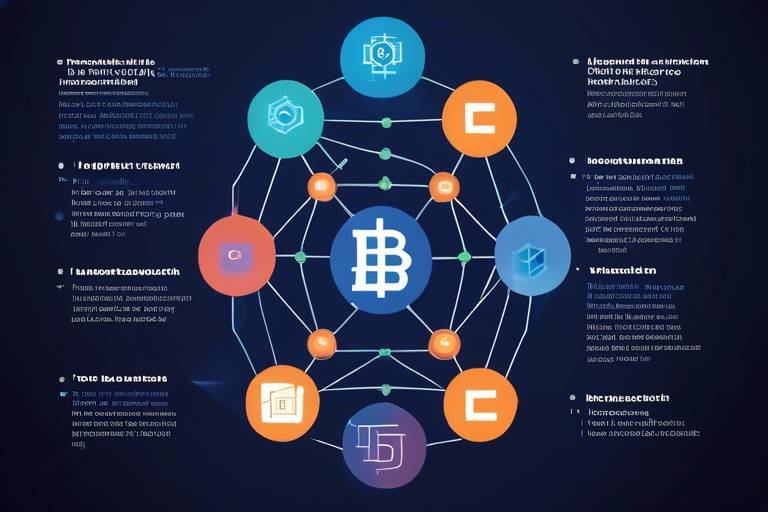The Use of Blockchain in Protecting Journalistic Integrity
In today's fast-paced digital landscape, where misinformation spreads like wildfire, the need for credible journalism has never been more critical. Blockchain technology emerges as a beacon of hope, offering innovative solutions to enhance transparency, accountability, and trust in news reporting. Imagine a world where every piece of information is traceable, verifiable, and immune to tampering. This is not just a dream; it’s a reality that blockchain can help create. By leveraging its decentralized nature, journalists can safeguard the integrity of their work while empowering audiences to discern fact from fiction. So, how exactly does blockchain work its magic in the realm of journalism? Let’s dive deeper into the fundamentals of this revolutionary technology.
Understanding blockchain technology is crucial to appreciate its applications in journalism. At its core, blockchain is a decentralized ledger system that records transactions across multiple computers. This means that no single entity has control over the entire database, making it incredibly difficult for anyone to alter or manipulate the information stored within it. Each transaction, or block, is linked to the previous one, creating a chain of information that is both secure and transparent. Think of it as a digital diary where every entry is permanent and visible to everyone, ensuring that the truth remains intact. This foundational technology can be a game-changer for journalism, especially in an era where trust is hard to come by.
One of the most pressing challenges in journalism today is the ability to verify sources and information. With the rise of fake news and digital manipulation, credibility is more important than ever. Blockchain can provide a reliable method for verifying sources, ensuring that they are authentic and traceable. By recording the origins of information on a blockchain, journalists can confidently assert the credibility of their sources. Imagine being able to trace a news article back to its original source with just a few clicks. This not only enhances the reliability of the information presented but also builds trust with the audience.
Using blockchain, journalists can track the origin of news articles seamlessly. This feature ensures that the information is credible and can be traced back to its source, significantly reducing the risk of spreading misinformation. For instance, if a journalist publishes a story about a political event, they can link it back to the original press release or eyewitness account recorded on the blockchain. This level of transparency is revolutionary, as it allows readers to see exactly where the information came from and how it has been verified.
One of the standout qualities of blockchain is its ability to create immutable records. Once information is recorded on the blockchain, it cannot be altered or deleted. This characteristic is vital for maintaining journalistic integrity and accountability. Imagine a scenario where a news outlet publishes a sensational story, only to later alter the details to suit their narrative. With blockchain, such tampering would be impossible. The original information remains intact, providing a clear and honest account of events. This level of security not only protects journalists but also serves the public by ensuring that they receive accurate and trustworthy news.
Examining real-world examples of blockchain in journalism illustrates its practical benefits. Several media organizations have begun to experiment with blockchain technology, showcasing its potential to transform the industry. For instance, the Associated Press has utilized blockchain to streamline its data-sharing processes, ensuring that information is accurate and timely. Similarly, platforms like Civil have emerged, allowing journalists to publish their work while maintaining control over their content, free from the constraints of traditional media. These case studies not only demonstrate the effectiveness of blockchain but also inspire other journalists to explore its possibilities.
Transparency is essential in journalism, and blockchain fosters openness in reporting practices. By allowing audiences to see the entire process behind news creation, blockchain encourages accountability among journalists. When readers can trace the origins of a story and verify its sources, they are more likely to trust the information presented. This transparency can lead to a more informed public, capable of making educated decisions based on reliable news. In a world where misinformation is rampant, fostering transparency is a crucial step toward restoring faith in journalism.
Blockchain can be a powerful tool against fake news. By providing a framework for verifying the authenticity of information, it helps identify and eliminate false narratives that can mislead the public. With the ability to track the source of information and ensure its integrity, journalists can combat the spread of fake news more effectively. This not only enhances the reliability of news outlets but also empowers audiences to discern fact from fiction.
Decentralized platforms enabled by blockchain can empower journalists by offering alternatives to traditional media. These platforms promote independent reporting and reduce bias, allowing journalists to share their stories without the influence of corporate interests. Imagine a world where journalists operate freely, unencumbered by the constraints of traditional media outlets. By leveraging blockchain, these platforms can ensure that diverse voices are heard, enriching the media landscape and providing audiences with a wider range of perspectives.
Collaboration is key to successfully integrating blockchain in journalism. It’s not just about the technology; it’s about the people behind it. Partnerships between journalists and technology experts can maximize the benefits of blockchain, leading to innovative solutions that enhance the integrity of news reporting. By working together, these two fields can create a more robust framework for journalism, ensuring that it remains a trusted source of information in an increasingly complex digital world.
- How does blockchain enhance journalistic integrity?
Blockchain enhances journalistic integrity by providing a secure and transparent way to verify sources, track information, and maintain immutable records. - Can blockchain completely eliminate fake news?
While blockchain cannot completely eliminate fake news, it significantly reduces the spread of misinformation by ensuring the authenticity of information. - Are there real-world examples of blockchain in journalism?
Yes, organizations like the Associated Press and platforms like Civil are successfully implementing blockchain technology in their reporting processes.

The Fundamentals of Blockchain Technology
Understanding blockchain technology is crucial to appreciate its applications in journalism. So, what exactly is blockchain? In simple terms, it's a decentralized ledger system that records transactions across many computers in such a way that the registered transactions cannot be altered retroactively. This means that once something is recorded on the blockchain, it’s there for good, creating a transparent and immutable record.
Imagine a digital notebook that everyone can see but no one can erase or modify. This is the essence of blockchain. It operates on the principle of distributed consensus, where multiple parties must agree on the validity of a transaction before it gets added to the chain. This characteristic not only enhances security but also builds trust among users, which is essential in fields like journalism where credibility is paramount.
One of the core components of blockchain is its blocks. Each block contains a list of transactions, a timestamp, and a unique code called a hash that links it to the previous block, forming a chain. This chain of blocks is stored across a network of computers, known as nodes. When a new transaction occurs, it is verified by the network through a consensus mechanism before being added to the blockchain.
To further clarify how blockchain operates, let’s break down its key features:
- Decentralization: Unlike traditional systems that rely on a central authority, blockchain distributes data across a network, reducing the risk of corruption or failure.
- Transparency: All participants can view the entire transaction history, which fosters accountability.
- Security: Advanced cryptographic techniques secure the data, making it extremely difficult for unauthorized parties to tamper with it.
- Immutability: Once recorded, data cannot be changed or deleted, ensuring the integrity of information.
These features make blockchain an appealing solution for various sectors, particularly journalism. With the rise of misinformation and digital manipulation, the need for a reliable system to verify sources and ensure the authenticity of information has never been more critical. By utilizing blockchain, journalists can create a more trustworthy environment for news reporting, ultimately enhancing their credibility and the public's confidence in media.
In summary, blockchain technology represents a paradigm shift in how we think about data integrity and trust. Its decentralized nature, combined with robust security features, positions it as a powerful tool for safeguarding journalistic integrity in an age where misinformation runs rampant.

In the fast-paced world of journalism, where headlines can change in the blink of an eye, the need for verifiable sources has never been more critical. Blockchain technology emerges as a beacon of hope in this chaotic landscape, offering a robust solution to enhance credibility and trustworthiness in news reporting. By leveraging blockchain, journalists can ensure that the information they present is not only accurate but also traceable back to its origin. Imagine a world where every piece of information can be verified—where readers can instantly check the authenticity of a source with just a click. This is the promise that blockchain holds for journalism.
One of the most significant advantages of blockchain in verifying sources is its decentralized nature. Unlike traditional databases that can be manipulated or corrupted, a blockchain operates on a network of computers, making it nearly impossible to alter or falsify information without consensus from the network. This characteristic is vital in an era where misinformation can spread like wildfire. By recording the details of sources on a blockchain, journalists can create a permanent, tamper-proof record that enhances the credibility of their reporting.
Furthermore, blockchain technology allows for the creation of digital identities for sources. Each source can be assigned a unique cryptographic key that links them to the information they provide. This not only helps in verifying the authenticity of the source but also ensures that they can be held accountable for the information shared. In a world where anonymous tips and unverified claims abound, this system of accountability can act as a safeguard against the spread of false narratives.
As journalists begin to adopt blockchain for source verification, they can implement several key practices:
- Source Registration: Journalists can register their sources on the blockchain, creating a transparent record of who provided the information.
- Timestamping: Every piece of information can be timestamped, providing a clear timeline of when the information was received and by whom.
- Chain of Custody: The blockchain can maintain a chain of custody for information, ensuring that it has not been altered or tampered with before reaching the public.
Moreover, the ability to track the origin of news articles is a game-changer. By utilizing blockchain, journalists can trace back the lineage of their stories, ensuring that every claim made is supported by credible evidence. This process not only boosts the integrity of the news but also fosters a culture of accountability within the journalism community. Readers are more likely to trust news outlets that can provide transparent sourcing, leading to a more informed public.
In conclusion, the integration of blockchain technology into journalism is not just a trend; it is a transformative step towards enhancing the credibility and integrity of news reporting. As the media landscape continues to evolve, embracing innovative solutions like blockchain will be essential in combatting misinformation and restoring public trust in journalism.

In today's fast-paced digital landscape, where information spreads like wildfire, the ability to track the origin of news articles is more critical than ever. Misinformation can easily slip through the cracks, leading to confusion and distrust among audiences. Imagine a world where every piece of news is like a well-documented package, complete with a tracking number that allows readers to see exactly where it came from and how it was handled along the way. This is where blockchain technology steps in, offering a powerful solution to enhance the credibility of news reporting.
Blockchain functions as a decentralized ledger, which means that every transaction or piece of information is recorded in a way that is transparent and immutable. When a journalist publishes an article, the details of that article—including the time it was written, the sources cited, and any edits made—can be securely logged on the blockchain. This not only provides a clear timeline of the article’s development but also ensures that the information remains intact and unaltered. Think of it as a digital fingerprint for every piece of news; once it's recorded, it cannot be erased or modified without leaving a trace.
One of the most significant advantages of this system is that it allows readers to verify the authenticity of the information they consume. By scanning a simple QR code or entering a unique identifier, audiences can access the blockchain records associated with a news article. This transparency fosters trust, as readers can see firsthand the sources and evidence that support the claims made in the article. No longer will they have to rely solely on the credibility of the publication; they can independently verify the information, much like checking the reviews of a product before making a purchase.
Moreover, the ability to track the origin of news articles extends beyond just verifying sources; it also helps in combating plagiarism and ensuring proper attribution. In a world where content is often reused and repurposed, knowing the original source of information is crucial. Blockchain can help establish a clear chain of custody for ideas and reporting, ensuring that journalists receive the credit they deserve for their hard work. This not only promotes ethical journalism but also encourages innovation and creativity within the industry.
As we continue to grapple with the challenges posed by misinformation, the integration of blockchain technology into journalism is not just a futuristic idea; it’s a necessary evolution. By enabling the tracking of news articles from their inception to their publication, blockchain empowers both journalists and readers alike. It creates a more informed public, helps to uphold journalistic standards, and ultimately, fosters a healthier media landscape.

In the fast-paced world of journalism, where the truth can sometimes feel like a fleeting shadow, the concept of immutable records offered by blockchain technology is nothing short of revolutionary. Imagine a world where every piece of information published is permanently etched in stone—well, that’s what blockchain achieves. Once data is recorded on a blockchain, it cannot be altered or deleted, creating a permanent, tamper-proof history of all transactions. This characteristic is crucial for journalists striving to maintain their credibility and integrity in an era rife with misinformation and digital manipulation.
Think of it this way: if you were to compare traditional journalism to a game of telephone, where messages can get distorted as they pass from one person to another, blockchain acts as a high-fidelity recording device that captures the original message. By ensuring that the information remains unchanged, blockchain allows journalists to present facts that are verifiable and trustworthy. This not only enhances the credibility of the news reported but also fosters a deeper level of trust between journalists and their audiences.
Moreover, the immutability of blockchain records serves as a safeguard against the manipulation of information. In a landscape where fake news can spread like wildfire, having a reliable source to refer back to is invaluable. For example, when a news article is published, the original data and any updates made to that article can be logged on the blockchain. This means that if someone tries to alter the original content after publication, the immutable record will reveal the discrepancies, effectively holding individuals accountable for their actions.
To illustrate the significance of immutable records, consider the following table that summarizes key benefits:
| Benefit | Description |
|---|---|
| Accountability | Immutable records hold journalists accountable for their reporting, ensuring that any changes or updates are transparent. |
| Trust | Audiences can trust that the information they receive is accurate and has not been tampered with. |
| Verification | Sources and information can be easily verified, which enhances the overall credibility of news reporting. |
In conclusion, the importance of immutable records in journalism cannot be overstated. They not only serve as a protective measure against misinformation but also as a tool for enhancing the overall quality of news reporting. As journalists increasingly turn to blockchain technology, we can expect to see a significant shift towards more transparent, reliable, and accountable journalism practices that ultimately benefit society as a whole.
- What is blockchain technology?
Blockchain is a decentralized digital ledger that records transactions across many computers in a way that the registered information cannot be altered retroactively.
- How does blockchain enhance journalistic integrity?
By providing immutable records, blockchain helps ensure that information cannot be tampered with, thereby enhancing the credibility of news reporting.
- Can blockchain help combat fake news?
Yes, blockchain can help verify sources and track the origin of information, making it easier to identify and eliminate false news.

In the realm of journalism, the integration of blockchain technology isn't just a futuristic concept; it's already happening! Numerous organizations around the globe are harnessing the power of blockchain to enhance their credibility and transparency. One standout example is Everipedia, a decentralized encyclopedia that utilizes blockchain to create a transparent and verifiable platform for knowledge sharing. By allowing users to edit and verify entries through a blockchain ledger, Everipedia ensures that information is not only accurate but also traceable. This innovative approach has revolutionized the way we view information, making it more reliable than traditional sources.
Another compelling case is Civil, a platform designed to empower journalists and media organizations through blockchain technology. Civil provides a decentralized marketplace for newsrooms, enabling them to publish content while ensuring that their work is protected from censorship and manipulation. By using smart contracts, Civil guarantees that journalists receive compensation for their work, fostering an environment where quality journalism can thrive without the influence of corporate interests. The success of Civil illustrates how blockchain can create a sustainable model for journalism that prioritizes integrity and accountability.
Furthermore, the Associated Press (AP) has taken significant strides in utilizing blockchain for its news reporting. The AP partnered with a blockchain technology firm to create a system that tracks the provenance of its news stories. This initiative not only helps in verifying the authenticity of information but also allows readers to trace the origins of news articles. The AP's efforts highlight how established news organizations can adopt blockchain technology to bolster their credibility amidst a landscape rife with misinformation.
These case studies demonstrate that the potential of blockchain in journalism is not just theoretical; it is being realized in practical, impactful ways. By implementing blockchain, these organizations are setting new standards for transparency and accountability, paving the way for a more trustworthy media landscape. As more journalists and media outlets explore blockchain solutions, we can expect to see a significant shift in how news is reported and consumed. The future of journalism, fortified by blockchain, promises to be more reliable, transparent, and resilient against the tides of misinformation.
- What is blockchain technology?
Blockchain is a decentralized digital ledger that records transactions across many computers securely, ensuring that the recorded data cannot be altered retroactively.
- How can blockchain enhance journalism?
Blockchain can enhance journalism by providing a transparent and immutable record of news articles, verifying sources, and reducing the spread of misinformation.
- Are there any successful examples of blockchain in journalism?
Yes, examples include Everipedia, Civil, and the Associated Press, all of which have successfully implemented blockchain to improve transparency and credibility.
- Can blockchain prevent fake news?
While blockchain cannot eliminate fake news entirely, it can significantly reduce its prevalence by verifying sources and ensuring the authenticity of information.

In an age where trust in journalism is wavering, transparency has become the golden key to restoring faith in news outlets. Imagine a world where every piece of information has a clear lineage, where readers can trace the origin of a story just like tracking a package through a delivery service. This is where blockchain technology steps in, acting as a beacon of hope for journalistic integrity.
By utilizing blockchain, news organizations can create an open ledger that allows the public to see the entire lifecycle of a news article—from the initial tip-off to the final published piece. This level of transparency not only enhances credibility but also empowers readers to make informed decisions about the information they consume. For instance, if a journalist cites a source, blockchain can verify its authenticity, ensuring that the information is not just a rumor or hearsay.
Furthermore, the transparency offered by blockchain can significantly reduce the chances of manipulation and bias. When the processes behind news creation are visible, it becomes much harder for any single entity to push a narrative without scrutiny. In this way, blockchain acts like a digital watchdog, ensuring that all stakeholders in the journalism ecosystem—journalists, editors, and the audience—are held accountable for their roles.
To illustrate this, consider a scenario where a news article is published about a sensitive political issue. With blockchain, each edit, each source citation, and each piece of evidence can be recorded immutably. This not only provides a clear audit trail but also allows for easy fact-checking. Readers can see who reported what, when, and how the information evolved. This level of detail can help dispel doubts and reinforce trust in journalism.
Moreover, transparency fosters a culture of collaboration. When journalists know their work is subject to public scrutiny, they are more likely to collaborate with others in the field, share insights, and engage in healthy discussions. This collaborative spirit can lead to richer, more nuanced reporting that benefits everyone involved—from the journalist to the reader.
In summary, by promoting transparency through blockchain technology, journalism can reclaim its role as a reliable source of information in a world overflowing with misinformation. The ability to verify sources, track the evolution of stories, and hold all parties accountable is crucial for a healthy democracy. As we move forward, the integration of blockchain into journalism could very well be the game-changer we've all been waiting for.

In a world where information overload is the norm, the battle against fake news has become increasingly critical. With the rise of social media and the rapid dissemination of information, the lines between truth and falsehood have blurred. This is where blockchain technology steps in as a formidable ally in the fight against misinformation. By leveraging its decentralized nature, blockchain can provide a transparent and verifiable way to track the origins and authenticity of news articles, ensuring that what we read is credible and trustworthy.
Imagine a scenario where every news article published is timestamped and recorded on a blockchain. This means that every piece of information is not just a fleeting thought but a permanent record that can be traced back to its source. With this level of accountability, journalists can confidently report on stories knowing that their sources are validated and transparent. This is not merely a theoretical concept; it’s a practical solution that can transform how we consume news. The ability to trace the origins of information can drastically reduce the spread of false narratives and sensationalism that often plagues traditional media.
One of the most significant advantages of blockchain in combatting fake news is its immutable records. Once data is entered into the blockchain, it cannot be altered or deleted. This characteristic is vital in maintaining the integrity of news reporting. For instance, if a news outlet publishes a story based on a particular source, that source can be verified through the blockchain, ensuring that any attempts to manipulate or alter the information are easily detectable. This creates a culture of accountability, making it more challenging for false information to thrive.
Moreover, the decentralized nature of blockchain empowers individuals and independent journalists. It allows them to bypass traditional media gatekeepers and report on stories that matter without the fear of censorship or bias. This democratization of information can lead to a more diverse range of voices in journalism, ultimately enriching the media landscape. In this environment, the public can access a broader spectrum of viewpoints, making it easier to discern fact from fiction.
To further illustrate the effectiveness of blockchain in combatting fake news, consider the following table that highlights some key benefits:
| Benefit | Description |
|---|---|
| Transparency | Allows audiences to verify the sources of news articles. |
| Accountability | Immutable records prevent tampering and ensure that information remains intact. |
| Decentralization | Empowers independent journalists and reduces bias. |
| Traceability | Enables tracking of information origins to verify authenticity. |
In conclusion, blockchain technology is not just a buzzword; it’s a revolutionary tool that can significantly enhance the credibility of journalism. By providing a secure and transparent framework for verifying information, blockchain can help combat the pervasive issue of fake news. As we continue to navigate the complexities of the digital age, embracing such innovations will be crucial in restoring trust in media and ensuring that journalism remains a reliable source of information for all.
- What is blockchain technology? - Blockchain is a decentralized ledger system that records transactions across multiple computers in a way that ensures the security and integrity of the data.
- How does blockchain help in verifying news sources? - By providing a permanent record of information and its origins, blockchain allows journalists and audiences to trace back to the source, ensuring authenticity.
- Can blockchain eliminate fake news completely? - While blockchain can significantly reduce the spread of fake news by enhancing transparency and accountability, it may not eliminate it entirely, as human factors still play a role.

In today's fast-paced digital landscape, the importance of decentralized platforms cannot be overstated, especially when it comes to journalism. These platforms leverage blockchain technology to create a more democratic and transparent environment for news reporting. Imagine a world where journalists are not just pawns in a corporate game, but empowered individuals who can share their stories without the fear of censorship or manipulation. This is the promise that decentralized platforms bring to the table.
One of the most significant advantages of decentralized platforms is their ability to reduce bias in reporting. Traditional media outlets often have their narratives shaped by corporate interests, leading to a skewed representation of facts. In contrast, decentralized platforms operate on a peer-to-peer basis, allowing journalists to share their work directly with audiences. This not only empowers independent reporting but also opens the door for a broader range of voices to be heard. Think of it as a bustling marketplace where every journalist can showcase their wares without the constraints of gatekeepers.
Moreover, decentralized platforms foster a sense of community among journalists and their audiences. When reporters and readers can interact directly, it creates a feedback loop that enhances the quality of journalism. For instance, readers can provide immediate feedback, share their insights, and even contribute to the narrative by presenting their perspectives. This collaborative approach not only enriches the content but also builds trust between journalists and their audience.
To illustrate the impact of decentralized platforms, consider the following benefits:
- Enhanced Security: Journalists can publish their work without fear of censorship or hacking, as decentralized systems are inherently more secure.
- Direct Monetization: Journalists can earn directly from their content through microtransactions, subscriptions, or donations, reducing reliance on advertising revenue.
- Global Reach: Decentralized platforms allow journalists to reach a global audience, breaking down geographical barriers that often limit traditional media.
In conclusion, the role of decentralized platforms in journalism is not just a technological advancement; it's a revolution in how news is created, shared, and consumed. By empowering journalists and fostering direct relationships with audiences, these platforms are paving the way for a more honest and transparent media landscape. As we continue to navigate the challenges of misinformation and bias, embracing decentralized platforms could very well be the key to restoring faith in journalism.
Q1: What are decentralized platforms in journalism?
A decentralized platform in journalism is a system that allows journalists to publish and share their work directly with audiences without the interference of traditional media gatekeepers. This is often facilitated by blockchain technology, which ensures transparency and security.
Q2: How do decentralized platforms reduce bias in reporting?
Decentralized platforms enable independent journalists to share their stories without corporate influence. This allows for a wider variety of perspectives and reduces the chances of bias that often comes from traditional media outlets.
Q3: Can decentralized platforms help combat misinformation?
Yes! By providing a transparent and traceable method for publishing news, decentralized platforms can help verify sources and information, making it harder for misinformation to spread.
Q4: What are the benefits of using blockchain in journalism?
The benefits include enhanced security, direct monetization for journalists, and a global reach that transcends geographical limitations. Blockchain also ensures the integrity of the information published.

In today's fast-paced digital landscape, the fusion of journalism and technology is not just beneficial; it's essential. As the media industry grapples with the challenges of misinformation and digital manipulation, the collaboration between journalists and tech experts emerges as a beacon of hope. Imagine a world where news is not only reported but also verified through advanced technological systems—this is the future we are heading towards thanks to blockchain technology.
Journalists are the storytellers of society, tasked with the critical responsibility of informing the public. However, in an age where anyone can publish content online, the challenge of ensuring accuracy and credibility has never been more daunting. This is where tech experts come into play. By leveraging their skills in blockchain technology, they can provide journalists with the tools necessary to enhance the integrity of their reporting.
For instance, consider the process of verifying sources. Journalists often rely on a network of contacts, but how can they ensure that these sources are legitimate? Through blockchain, each source can be linked to a unique digital signature. This not only authenticates the source but also allows for traceability. Tech experts can help journalists implement these systems, ensuring that every piece of information is backed by credible evidence. This collaboration can transform the way news is sourced and reported, fostering a culture of accountability.
Moreover, the integration of blockchain can streamline the workflow of news production. Journalists can work alongside tech professionals to develop decentralized platforms where news can be published directly, bypassing traditional gatekeepers. This empowers independent journalism and encourages diverse voices, reducing the bias often seen in mainstream media. By creating a transparent reporting process, both journalists and tech experts can work together to build trust with their audience.
However, successful collaboration requires open communication and a shared vision. Journalists must be willing to embrace technology and learn from their tech counterparts, while tech experts need to understand the nuances of journalistic ethics and the importance of storytelling. This symbiotic relationship can lead to innovative solutions that enhance the quality of news reporting.
As we look to the future, fostering partnerships between journalists and tech experts will be crucial. By working together, they can not only combat the spread of fake news but also elevate the standards of journalism. Together, they can create a robust framework that not only protects journalistic integrity but also empowers the next generation of reporters.
- What is the role of blockchain in journalism? Blockchain technology provides a transparent and immutable record of information, helping to verify sources and enhance credibility in news reporting.
- How can journalists benefit from collaborating with tech experts? By working with tech experts, journalists can implement advanced technologies that improve the accuracy and reliability of their reporting.
- What challenges do journalists face in the digital age? Journalists face challenges such as misinformation, digital manipulation, and the need for rapid news production, which can compromise the integrity of reporting.
- How does blockchain help combat fake news? Blockchain allows for the verification of sources and the tracking of information, making it easier to identify and eliminate false information.
Frequently Asked Questions
- What is blockchain technology?
Blockchain technology is a decentralized ledger system that records transactions across multiple computers. This ensures that the recorded data is secure, transparent, and cannot be altered retroactively. It's like a digital notebook that everyone can see but no one can erase or change without consensus.
- How does blockchain enhance journalistic integrity?
Blockchain enhances journalistic integrity by providing a secure method for verifying sources and tracking the origin of news articles. This transparency helps combat misinformation and ensures that the information journalists present is credible and trustworthy.
- Can blockchain help in combatting fake news?
Absolutely! Blockchain can be a powerful tool against fake news by allowing for the verification of information at its source. By establishing immutable records, it helps identify and eliminate false information, making news outlets more reliable.
- What are immutable records, and why are they important?
Immutable records are entries on the blockchain that cannot be changed or deleted. This is crucial for maintaining journalistic integrity because it prevents tampering and ensures that the information remains accurate and trustworthy over time.
- How can journalists collaborate with tech experts?
Collaboration between journalists and tech experts is essential for effectively integrating blockchain into journalism. By working together, they can develop innovative solutions that enhance reporting practices and ensure that the technology meets the specific needs of the media industry.
- What are decentralized platforms in journalism?
Decentralized platforms are media outlets that operate without a central authority, often enabled by blockchain technology. These platforms empower journalists to publish their work independently, reducing bias and promoting diverse voices in the media landscape.
- How does blockchain improve transparency in reporting?
Blockchain improves transparency in reporting by allowing audiences to trace the entire process behind news creation. This means that readers can see where the information comes from, how it was gathered, and who reported it, fostering a deeper trust in the news they consume.



















